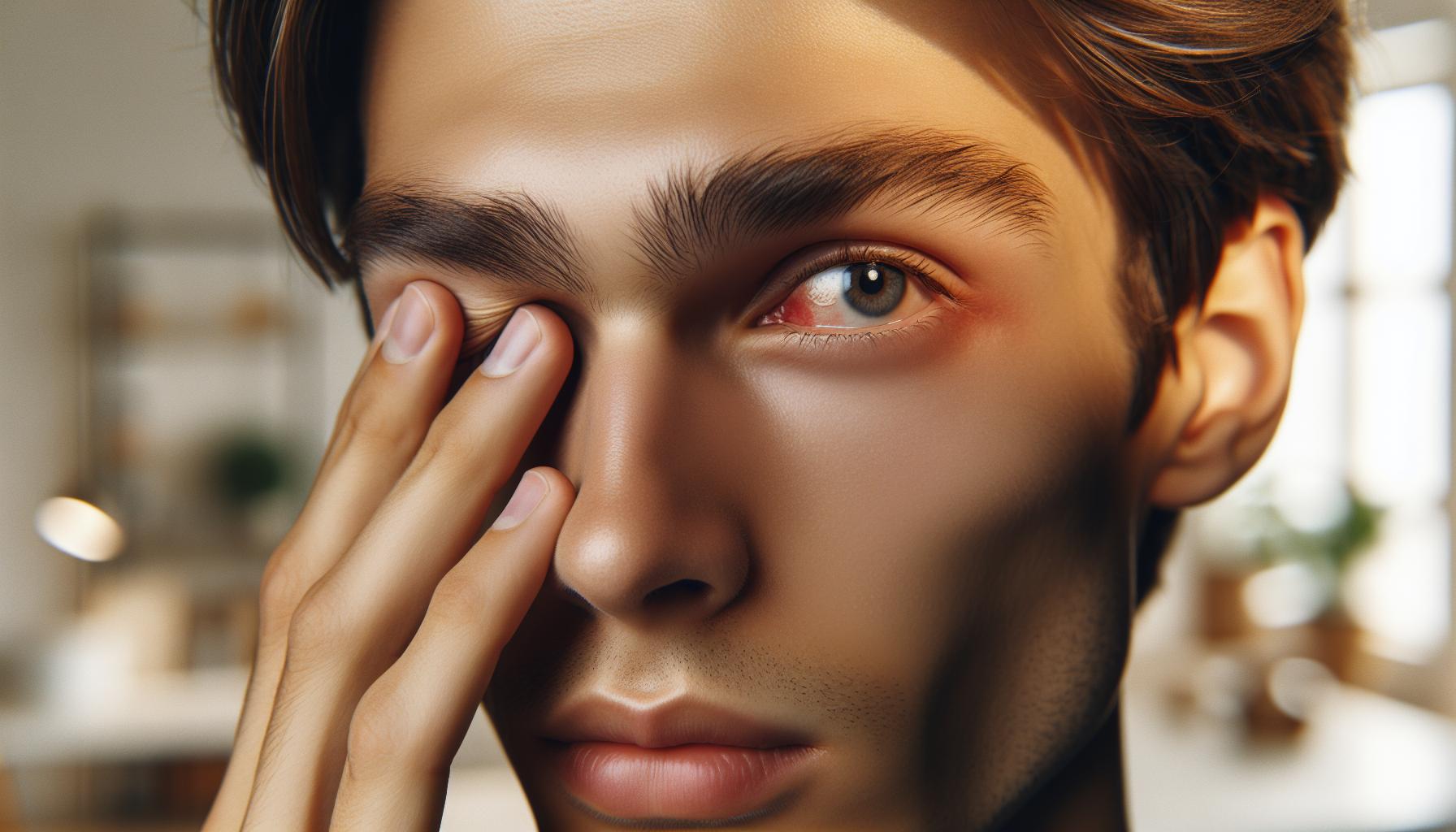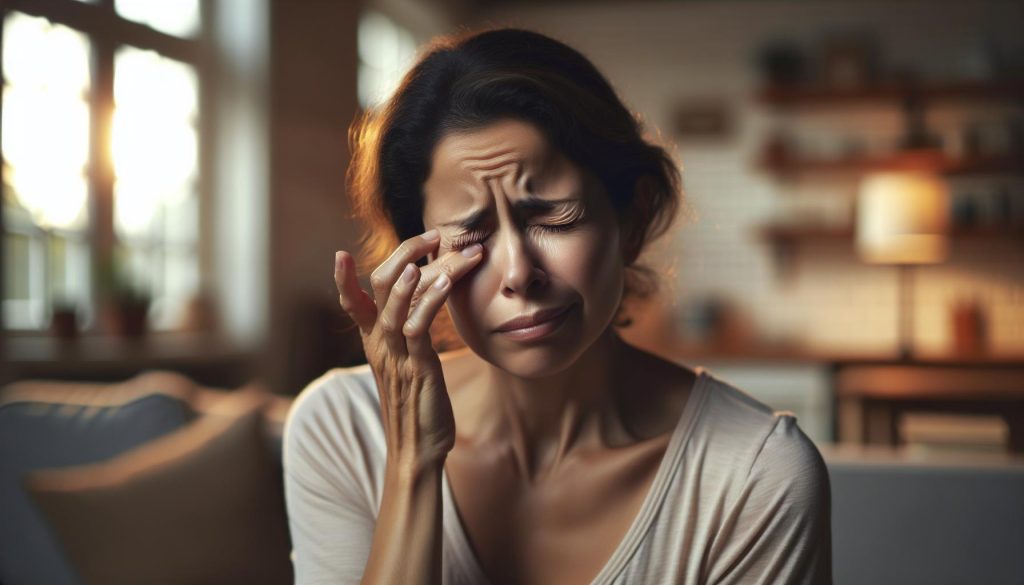A stye, often perceived as a mere nuisance, can raise genuine concerns about eye health and comfort. While these painful bumps along the eyelash line are commonly treatable with home remedies, they can pose risks to your vision if not managed properly. Understanding the potential for a stye to irritate or scratch the eye is crucial for anyone experiencing this condition.
Many people overlook the importance of timely care or might not know how to address the discomfort effectively. By educating yourself on the symptoms, causes, and protective measures against styes, you can maintain eye health and ward off complications. Continue reading to discover practical tips and insights for safeguarding your vision while navigating this common eyelid condition.
Understanding What a Stye Is and Its Causes
A stye, medically known as a hordeolum, is a common and often painful condition that manifests as a red, swollen bump on the eyelid, resembling a pimple. This irritating bump arises from a bacterial infection of the oil glands located at the base of the eyelashes. Styes can develop quickly, often appearing suddenly with no warning, usually within a few days. They are frequently caused by the Staphylococcus bacteria, which are typically found on the skin. However, factors such as poor hygiene, stress, or underlying skin conditions can increase the risk of developing a stye.
Inflammation and blockage of the meibomian or sebaceous glands lead to the formation of a stye. When these glands become obstructed, the trapped oil and bacteria create an ideal environment for a bacterial infection. Thus, maintaining eye and facial hygiene is essential. Regular cleansing helps prevent the buildup of oils and bacteria that can lead to these infections. It’s worth noting that there are two types of styes: external, which occurs on the outer part of the eyelid, and internal, which forms on the inner surface. Both can be uncomfortable and may lead to symptoms such as irritation, tearing, and light sensitivity.
Understanding the underlying causes of styes can empower individuals to adopt preventative measures. For instance, practicing good hygiene, such as washing your hands before touching your face or eyes, using clean towels, and avoiding sharing cosmetics, can significantly reduce the likelihood of developing a stye. By recognizing the symptoms early and implementing these preventive strategies, you can protect your vision and maintain better eye health. If a stye does occur, stay calm; they are usually harmless and tend to resolve on their own but keeping a watchful eye on your symptoms is vital.
Does a Stye Pose a Threat to Your Eye?
Experiencing a stye can be concerning, and many people wonder whether it poses a real threat to their eyes. The good news is that while a stye, or hordeolum, can be uncomfortable and may cause irritation, it typically does not lead to serious vision problems. Styes result from bacterial infections of the oil glands at the base of the eyelashes, leading to localized swelling and redness, but they remain largely superficial.
However, it’s essential to be attentive to symptoms. An untreated stye can potentially worsen, resulting in increased pain and swelling. In rare cases, if the infection spreads, it could lead to more significant complications like preseptal cellulitis, which causes swelling around the eye, or, even more infrequently, conjunctivitis. If you notice excessive swelling, severe pain, or vision changes, seek medical advice promptly.
To minimize any risks and protect your vision, maintain proper hygiene practices. Wash your hands frequently, avoid touching or rubbing your eyes, and clean your eyelids gently with a warm compress to help relieve discomfort and promote drainage. Being proactive in your eye care can help you manage and prevent styes effectively, allowing you to maintain your visual health without fear.
Key Symptoms of a Stye You Should Never Ignore
Experiencing discomfort or irritation around your eyelids can be annoying, but understanding the key symptoms of a stye can help you address the issue promptly. A stye, characterized by a painful, swollen bump on the eyelid, typically arises from an infection in the oil glands near the eyelashes. Being able to recognize early signs is crucial for effective treatment and to prevent potential complications.
The most common symptoms of a stye include:
- Pain and tenderness: Initial sensations may feel like a throbbing or persistent ache at the site of the bump.
- Swelling: A noticeable puffiness around the eyelid is often one of the first alerts that something is off.
- Redness: The affected eyelid may become red and inflamed, which can be alarming but is a typical response to infection.
- Discharge: In some cases, a stye might lead to discharge, which can be a clear fluid or pus.
- Light sensitivity: If you notice an increase in sensitivity to light, it may be a sign that your stye is causing irritation to your overall eye health.
While a stye is generally not serious, ignoring these symptoms can lead to increased discomfort or even the formation of a chalazion, which is a larger, blocked gland that may require medical intervention. If you start experiencing more severe symptoms such as intense swelling that impacts your ability to open your eye, fever, or significant vision changes, it’s crucial to consult a healthcare professional. Prompt attention to your symptoms not only helps alleviate discomfort but also safeguards your eye health. Remember, listening to your body is key; don’t hesitate to take action when something feels off.
The Connection Between Styes and Vision Problems
A stye, while often a minor annoyance, can indeed impact your vision if left untreated. It’s important to recognize that this small bump, usually resulting from an infection in the oil glands of the eyelid, can lead to a series of complications that might affect your eye health. When a stye develops, it may cause swelling and pressure that can impede your ability to see clearly. In some cases, the inflammation can affect the surrounding areas of your eye, leading to discomfort and temporary vision blurriness.
Additionally, if you frequently rub your eyes due to the irritation caused by a stye, you run the risk of scratching your cornea unintentionally. Such damage could result in more severe complications, including infections or corneal abrasions, which may require medical treatment. Therefore, addressing a stye promptly is essential; early intervention not only alleviates discomfort but also protects your vision from potential harm.
It’s also worth noting that recurrent styes can indicate underlying issues such as chronic blepharitis or other skin conditions. If you’re experiencing frequent styes, consider discussing this with your healthcare provider, who can provide personalized recommendations for maintaining your eye health. Regular hygiene routines, such as cleaning your eyelids with warm compresses or avoiding touching your face, can help reduce the risk of both styes and the potential vision problems they may bring. Taking these proactive steps ensures that your eyes remain healthy, minimizing any risks linked to stye-related issues.
Quick Strategies to Prevent Styes from Developing
Keeping your eyes healthy is not just about addressing issues as they arise; it’s also about preventive strategies that can help you avoid conditions like styes. These pesky bumps can occur when the oil glands in your eyelids get clogged, often due to bacteria, dirt, or a lack of proper hygiene. By implementing a few straightforward habits, you can significantly reduce your risk of developing styes.
Start with a gentle yet effective eyelid cleansing routine. Regularly clean your eyelids using warm compresses or eyelid scrubs. This can help remove debris, bacteria, and excess oil that could inhibit gland function. It’s especially important if you wear makeup or if you have conditions like blepharitis (inflammation of the eyelids). When washing your face, be gentle around the eye area, and avoid using harsh soaps or cleansers that can irritate the delicate skin.
Another essential strategy is to be mindful of your hands. Remember that your hands come into contact with many surfaces throughout the day, which can harbor germs and bacteria. Make it a habit to wash your hands frequently and avoid touching your eyes unless your hands are clean. If you tend to rub your eyes due to allergies or irritation, find alternative ways to alleviate discomfort, such as using antihistamines or artificial tears, rather than instinctively touching your face.
Furthermore, pay attention to your makeup and skincare products. Ensure that you use hypoallergenic products and replace makeup regularly to prevent contamination. It’s wise to avoid sharing eye makeup, and remember to remove makeup thoroughly before bed to ensure your eyelids and lashes stay clean overnight. Adopting these simple yet effective practices can create a healthier environment for your eyes, ultimately helping to prevent styes and enhance your overall vision health.
At-Home Remedies for Soothing Stye Discomfort
Dealing with a stye can be uncomfortable, but there are effective at-home remedies that can help alleviate the pain and swelling associated with this condition. One of the most soothing methods is applying a warm compress to the affected area. Simply soak a clean cloth in warm (not hot) water, wring it out, and place it gently over your eyelid for about 10-15 minutes, several times a day. The warmth helps to reduce inflammation and promotes drainage of the clog in the oil glands, speeding up healing.
Another practical remedy involves the use of diluted baby shampoo or eyelid scrub. Mix a few drops of baby shampoo with warm water, soak a cotton swab or clean cloth in this solution, and gently cleanse the eyelid area. This helps remove excess oil and debris without irritating the sensitive skin around the eyes. Remember to rinse with clean water afterward to ensure no residue remains, as this can prevent future irritation.
For those seeking quick relief, consider over-the-counter pain medications such as ibuprofen or acetaminophen to manage discomfort. Natural remedies like chamomile tea bags can also provide soothing effects; simply brew a bag, allow it to cool slightly, and place it on the stye for a calming effect. Ensure any items used are clean to prevent further irritation or infection.
Ultimately, maintaining good eyelid hygiene plays a crucial role in both prevention and treatment. Keep your eyelids clean, avoid touching or rubbing your eyes, and refrain from using makeup until the stye has completely healed, as this can introduce irritants or bacteria that worsen the condition. By incorporating these simple yet effective remedies and practices, you can significantly ease the discomfort that comes with a stye and help your body on its path to recovery.
When to Seek Medical Attention for a Stye
Experiencing a stye can be quite uncomfortable, and it’s essential to know when it’s time to consult a healthcare professional. While most styes will resolve on their own within a week or two, certain signs indicate that medical intervention might be necessary to protect your eye health. Recognizing these symptoms early on can prevent complications and ensure your vision remains unaffected.
If you notice that the stye is not improving, or if it continues to grow, it’s advisable to seek medical attention. A persistent or enlarging stye may suggest an underlying issue or infection that requires treatment beyond home remedies. Additional warning signs include intense pain, swelling that spreads to other parts of your face, or if you develop a fever. These symptoms could signify a more severe infection that needs immediate medical evaluation.
In some cases, styes can affect your vision, particularly if they become large enough to press against your eyeball or obstruct your field of vision. If you find yourself squinting or straining to see clearly because of a stye, it’s time to reach out to an eye care specialist. They can assess the situation and may provide treatments such as prescription medications or even minor surgical procedures to drain the stye.
Another important point to consider is if you have recurrent styes. If you’re experiencing multiple styes in a short period or have a history of frequent styes, scheduling an appointment with your healthcare provider is a good step. This pattern may indicate an issue with your eyelid hygiene, oil gland functioning, or even an underlying health condition that needs addressing. Taking these precautions helps ensure that your eyes stay healthy, and your vision remains sharp.
Safe and Effective Treatments for Styes
If you’re dealing with a stye, finding the right treatment is essential for your comfort and eye health. Styes, characterized by a red, swollen bump on the eyelid, are often caused by clogged oil glands, and while they usually resolve on their own, there are effective treatments to alleviate symptoms and hasten recovery.
One of the most recommended treatments is the application of warm compresses. Using a clean washcloth soaked in warm water, place it gently over the affected eye for about 10-15 minutes, multiple times a day. This practice helps to unblock the gland and encourages drainage, offering soothing relief from discomfort. It’s essential to ensure that the compress is warm-too hot can cause burns, while too cold may not be effective in softening the blockage.
In addition to warm compresses, over-the-counter pain relief medication like ibuprofen or acetaminophen can help manage any associated pain or discomfort. Remember to avoid squeezing or attempting to pop the stye, as this can worsen the infection or spread bacteria, complicating the situation further.
For those seeking additional support, topical antibiotic ointments, available through a pharmacy, can be applied as directed on the affected area. However, it’s vital to consult a healthcare provider before using medicinal treatments, especially if the stye does not improve within a week or shows signs of worsening.
Lastly, maintaining good eyelid hygiene plays a crucial role in treatment and prevention. Gently cleaning the eyelids with mild soap and water or baby shampoo can help keep the area free of bacteria and debris, which is essential for preventing future styes. With these treatments at hand, you can effectively manage styes and protect your vision, ensuring your eyes remain healthy and free from complications.
Understanding the Role of Hygiene in Eye Health
Maintaining hygiene around the eyes is crucial for preventing infections and ensuring overall eye health. The delicate skin of your eyelids is susceptible to bacteria and irritants, which can lead to conditions like styes. These small, painful bumps near the eyelash line occur when an oil gland becomes clogged and infected. By adopting a robust hygiene routine, you can significantly reduce your risk of developing styes and other eye-related issues.
To start with, it’s essential to wash your hands thoroughly before touching your face or eyes. This simple step is one of the best defenses against the transfer of bacteria. Additionally, regular cleaning of your eyelids is beneficial. Using a diluted tear-free baby shampoo or a mild soap can help remove debris, makeup, and oils that accumulate throughout the day. Gently wiping the eyelid area with a cotton pad soaked in the solution promotes cleanliness without causing irritation. Aim for this practice at least a few times a week, especially if you wear eye makeup regularly.
Avoid sharing personal items, such as towels, makeup brushes, or eye products, as this can lead to cross-contamination. It’s also advisable to regularly clean your makeup brushes and replace eye makeup products every few months to prevent bacterial growth. If you wear contact lenses, ensure they are properly cleaned and stored to minimize risks. When removing or inserting your lenses, always wash your hands before and after.
In summary, adopting a consistent hygiene routine is not only about preventing styes but also about safeguarding your vision and maintaining overall eye health. By following these simple yet effective steps, you empower yourself to enjoy clearer, healthier eyes while reducing the likelihood of discomfort and infection.
Common Myths About Styes Debunked
Many people hold misconceptions about styes, which can lead to unnecessary worry or misguided actions. Understanding these myths not only helps in effective management but also empowers you with knowledge that promotes eye health. One common myth is that styes are caused by poor hygiene. While it’s true that bacteria can contribute to the development of styes, this condition can arise even in individuals who maintain a meticulous skincare routine. Factors such as stress, hormonal changes, and underlying health conditions can also play a significant role, illustrating that styes are not solely a reflection of personal cleanliness.
Another prevalent myth is that styes are contagious. This misunderstanding can cause undue anxiety and prevent others from seeking necessary comfort or support. In reality, styes cannot be passed from person to person. They occur when oil glands in the eyelids become clogged and infected, usually by bacteria that are already present on your skin. It’s essential to communicate this information to family and friends to alleviate fears and encourage an environment of understanding rather than stigma.
Moreover, some people believe that styes will resolve on their own without any intervention. While many styes do clear up on their own, they can sometimes lead to more severe complications if not managed properly. Treating the discomfort with warm compresses can help reduce inflammation and promote drainage. Ignoring the symptoms or attempting to pop a stye can lead to further irritation or infection. It’s crucial to adopt a proactive approach to care, knowing when home remedies are suitable and when to consult a healthcare professional.
By dispelling these myths, you can take a more informed stance toward your eye health, minimizing fear and maximizing confidence in handling styes. Empowering yourself with accurate information not only helps in personal health management but also enables you to support others who may be struggling with similar concerns.
Post-Stye Care: Protecting Your Eyes Post-Recovery
Recovering from a stye isn’t just about dealing with the immediate discomfort; it’s also crucial to take steps that support your eye health long after the stye has resolved. After experiencing a stye, your eyelids might be more sensitive than usual, making it essential to adopt gentle care strategies to prevent recurrence and ensure they heal properly.
One of the first steps in post-stye care is to maintain hygiene around your eyes. Use a mild, non-irritating cleanser to gently wash your eyelids, removing any residual bacteria or debris. Incorporating warm compresses can still be beneficial; not only do they help to relieve discomfort, but they also promote circulation to aid healing. Aim to apply a clean, warm cloth to your eyes several times a day for about 10-15 minutes. This practice can help prevent blocked glands and reduce the likelihood of future styes.
It’s also important to monitor your skincare and makeup routines. Consider avoiding eye makeup for at least a week after the stye has healed to allow your eyes to recover without added irritation. If you must use makeup, opt for hypoallergenic products to lessen the risk of allergens aggravating your eyelids. Additionally, remember to clean your makeup brushes and tools regularly to prevent bacteria buildup, which can contribute to future issues.
Staying aware of your overall health could play a significant role in preventing styes. Dehydration, stress, and inadequate sleep can negatively impact your immune system, so prioritize a well-balanced diet, hydration, and proper rest. Incorporating foods high in antioxidants and essential fatty acids can support skin and eye health. Foods like fish, nuts, fruits, and vegetables provide nutrients that help in recovery and maintain the integrity of your skin.
Above all, try to identify and minimize any stressors that could lead to hormonal fluctuations or changes in skin conditions. Mindfulness practices or relaxation techniques can significantly improve your overall health and help you maintain a balanced lifestyle.
In summary, taking a proactive and gentle approach to eye care post-stye not only aids in your recovery but also empowers you to safeguard against future occurrences. By maintaining good hygiene, being mindful of your skincare practices, and caring for your overall health, you can help protect your vision and keep your eyes comfortable and healthy.
Empowering Your Eye Health: Tips for Long-Term Vision Care
Maintaining optimal eye health extends far beyond merely addressing immediate issues like styes; it’s about embracing a holistic approach that nurtures your vision for the long haul. The eyes are one of the most delicate and vital parts of the body, requiring consistent care that’s integrated into your daily life. One effective way to keep your eyes healthy is to prioritize a nutritious diet rich in vitamins and minerals. Incorporate foods high in omega-3 fatty acids, such as salmon, as well as leafy greens like spinach and kale, which support eye health. These nutrients can help combat dryness and reduce inflammation, making a substantial difference in your overall vision quality.
Moreover, hydration plays a critical role in eye health. Dehydration can lead to dry eyes and discomfort, potentially exacerbating issues like styes. Aim to drink plenty of water throughout the day, and consider using a humidifier at home to maintain moisture in the air, particularly in drier climates or during winter months.
When it comes to skincare and cosmetic routines, be mindful of the products you apply near your eyes. Avoid heavy or oily formulas that can clog your pores and lead to stye development. Instead, opt for non-comedogenic makeup and skincare products that won’t block your glands. Regularly cleaning your makeup brushes and applicators can also help minimize bacterial buildup, which is critical for maintaining eyelid hygiene.
Regular eye examinations are another essential component of long-term vision care. Scheduling routine visits with an eye care professional helps catch any potential issues before they escalate. If you’ve experienced repeated styes or other discomforts, keep your eye doctor informed, as they can provide tailored advice or treatments to keep your eyes healthy.
Incorporating protective measures like wearing sunglasses with UV protection and avoiding excessive screen time can contribute significantly to safeguarding your vision. Consider the 20-20-20 rule: every 20 minutes of screen time, look at something 20 feet away for at least 20 seconds. This simple tactic helps reduce eye strain and can prevent future discomfort and complications.
By taking these proactive steps, you empower yourself to maintain your eye health effectively. Your eyes deserve the best care and attention, not just when problems arise, but as an integral part of your overall wellness journey.
FAQ
Q: Can a stye cause damage to my eye?
A: A stye itself doesn’t typically cause direct damage to your eye but can lead to discomfort and complications if untreated. If a stye worsens or leads to a secondary infection, it may pose risks to your overall eye health. Always consult a healthcare provider for persistent concerns.
Q: How can I avoid scratching my eye with a stye?
A: To avoid scratching, avoid rubbing your eyes, even if there’s discomfort. Gently clean your eyelids with warm compresses to soothe irritation and reduce the risk of further injury. Practicing good hygiene is crucial to prevent spreading bacteria.
Q: What should I do if my stye feels like it’s scratching my eye?
A: If a stye feels like it’s scratching your eye, avoid touching it and apply a warm compress to reduce irritation. If symptoms persist or worsen, seek medical advice to prevent complications and determine the best treatment options.
Q: Are there any activities I should avoid with a stye?
A: Yes, avoid rubbing your eyes, wearing eye makeup, and swimming until the stye is healed. These activities can exacerbate irritation and increase the risk of infection. Prioritizing rest for your eyes is important during recovery.
Q: Can stress contribute to the development of a stye?
A: Yes, stress can weaken your immune system, potentially leading to the development of a stye. Managing stress through relaxation techniques and proper self-care can help reduce your chances of developing styes and protect overall eye health.
Q: What home remedies can help if my stye is bothering my eye?
A: Home remedies such as warm compresses can soothe discomfort and promote drainage of the stye. Clean your eyelid gently with diluted baby shampoo to maintain hygiene. These strategies can provide relief while preventing further irritation.
Q: How long does it take for a stye to heal?
A: A stye typically heals within 5 to 7 days with proper care. If it lasts longer or worsens, consult a healthcare professional to evaluate the situation and consider additional treatment options.
Q: When should I see a doctor for a stye?
A: See a doctor if your stye is particularly painful, red, swollen, or does not improve within a week. If you experience vision changes or excessive discharge, seek medical attention promptly to address potential complications.
These questions and answers focus on providing valuable insights for individuals concerned about styes and their impact on eye health. For more detailed information, check out the related sections of our article on styes.
Concluding Remarks
Taking care of your eyes is crucial, especially when dealing with conditions like styes. Remember, while a stye itself may not cause scratches, it can lead to discomfort and other complications if ignored. Act now to protect your vision by exploring effective eye care routines and remedies. For more in-depth guidance, check out our articles on natural stye treatments and preventive eye care tips.
Don’t miss out on taking proactive steps for your health-sign up for our newsletter for timely advice and exclusive content. Join the conversation in the comments below; share your experiences or ask questions! Your eyes deserve attention, so let’s keep them healthy together. Explore more valuable resources that empower you to make informed decisions about your eye care today!




